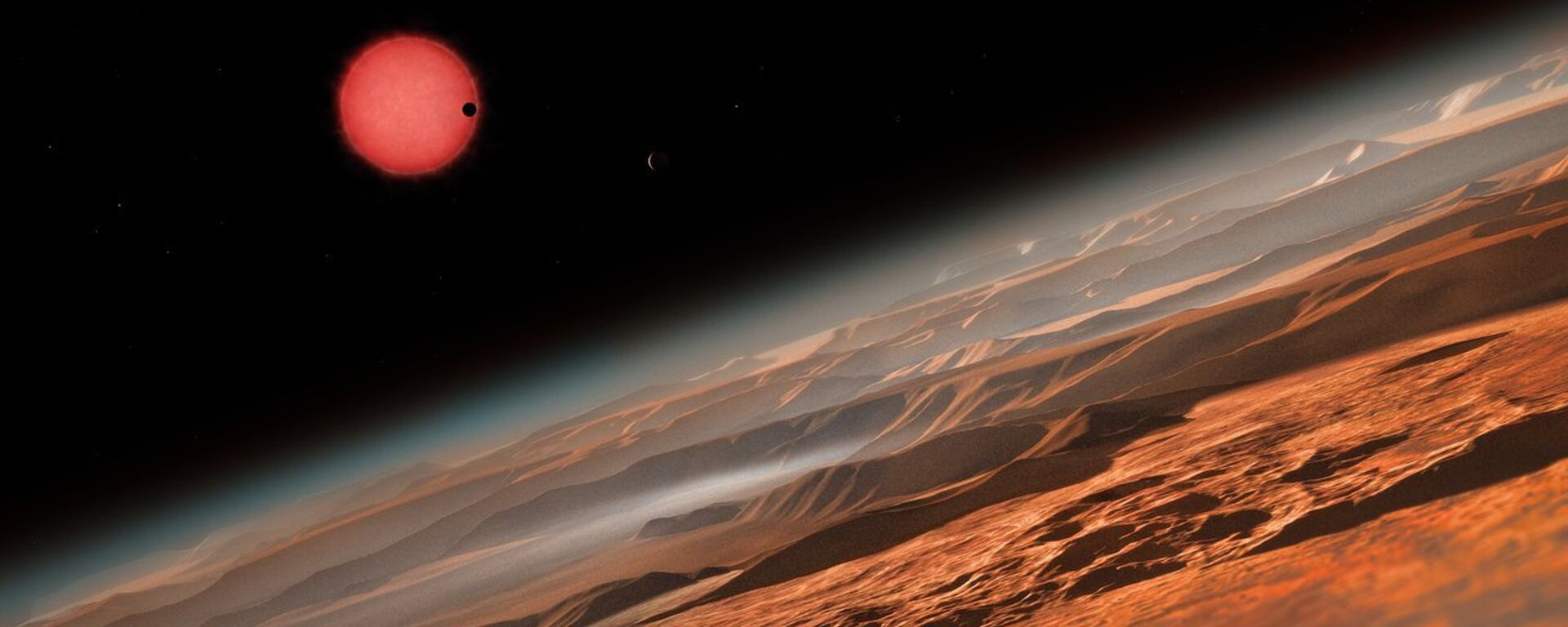https://sputnikglobe.com/20220806/james-webb-space-telescope-to-ascertain-potential-habitability-of-trappist-1-worlds-1099339200.html
James Webb Space Telescope to Help Ascertain Whether TRAPPIST-1 Worlds Are Habitable
James Webb Space Telescope to Help Ascertain Whether TRAPPIST-1 Worlds Are Habitable
Sputnik International
If the presence of an atmosphere on at least some of the TRAPPIST-1 planets is confirmed, the scientists would then try to determine the atmosphere’s... 06.08.2022, Sputnik International
2022-08-06T15:44+0000
2022-08-06T15:44+0000
2022-08-06T17:29+0000
science & tech
trappist-1
james webb space telescope (jwst)
planets
atmosphere
https://cdn1.img.sputnikglobe.com/img/07e5/08/1a/1083724858_0:131:600:469_1920x0_80_0_0_ac6b52ceaa2d162ee4efdb40a83f583a.png
While scientists strive to determine whether life could exist somewhere beyond Earth, a NASA researcher pointed at a crucial factor that may reveal whether exoplanets orbiting the TRAPPIST-1 star could potentially be habitable.Located in a star system about 40 light-years away, these planets have already been targeted by the recently launched James Webb Space Telescope (JWST) that is going to try to find whether these worlds have an atmosphere.And as NASA astrobiologist Shawn Domagal-Goldman has explained, this issue – the presence or absence of an atmosphere on these worlds – is “critical for habitability”."For exploration of potentially habitable worlds, the question of whether the TRAPPIST planets in the habitable zone have atmospheres is the most important scientific question or observation that anyone's going to focus on, with JWST or any other facility, probably for the next five or 10 years," he added.Observations that were made before JWST came online have already indicated that at least some of the rocky planets in the TRAPPIST-1 system orbit their star in the habitable zone.However, if the planets do have any atmosphere, scientists would also have to determine the composition of these atmospheres before making any conclusions about the habitability of these worlds.However, the presence of ozone and oxygen may be somewhat difficult to confirm since an atmosphere rich in them may feature cloud decks that can hinder their detection, though scientists may also set their sights on other potential biosignatures such as methane.
https://sputnikglobe.com/20220604/astronomers-find-super-earth-four-times-bigger-than-ours-in-close-stars-habitable-zone-1095992066.html
Sputnik International
feedback@sputniknews.com
+74956456601
MIA „Rossiya Segodnya“
2022
Sputnik International
feedback@sputniknews.com
+74956456601
MIA „Rossiya Segodnya“
News
en_EN
Sputnik International
feedback@sputniknews.com
+74956456601
MIA „Rossiya Segodnya“
Sputnik International
feedback@sputniknews.com
+74956456601
MIA „Rossiya Segodnya“
science & tech, trappist-1, james webb space telescope (jwst), planets, atmosphere
science & tech, trappist-1, james webb space telescope (jwst), planets, atmosphere
James Webb Space Telescope to Help Ascertain Whether TRAPPIST-1 Worlds Are Habitable
15:44 GMT 06.08.2022 (Updated: 17:29 GMT 06.08.2022) If the presence of an atmosphere on at least some of the TRAPPIST-1 planets is confirmed, the scientists would then try to determine the atmosphere’s composition and look for possible biosignatures.
While scientists strive to determine whether life could exist somewhere beyond Earth, a NASA researcher pointed at a crucial factor that may reveal whether exoplanets orbiting the TRAPPIST-1 star could potentially be habitable.
Located in a star system about 40 light-years away, these planets have already been targeted by the recently launched James Webb Space Telescope (JWST) that is going to try to find whether these worlds have an atmosphere.
And as NASA astrobiologist Shawn Domagal-Goldman has explained, this issue – the presence or absence of an atmosphere on these worlds – is “critical for habitability”.
“The moon gets just as much energy from the sun as the Earth does, but it doesn't hold onto its atmosphere and so it doesn't have any oceans and it doesn't have any global biosphere," Domagal-Goldman told Newsweek. "So it's a first-order question to answer for the habitability of these worlds: whether or not they do have atmospheres. It turns out that's also the easiest thing Webb can observe."
"For exploration of potentially habitable worlds, the question of whether the TRAPPIST planets in the habitable zone have atmospheres is the most important scientific question or observation that anyone's going to focus on, with JWST or any other facility, probably for the next five or 10 years," he added.
Observations that were made before JWST came online have already indicated that at least some of the rocky planets in the TRAPPIST-1 system orbit their star in the habitable zone.
However, if the planets do have any atmosphere, scientists would also have to determine the composition of these atmospheres before making any conclusions about the habitability of these worlds.
"If you want to look for the kinds of biosignatures that we have on Earth, which is to say oxygen and ozone from plants and algae, that's a great biosignature because if you see it, it's less likely to be produced by non-biological processes," said Domagal-Goldman.
However, the presence of ozone and oxygen may be somewhat difficult to confirm since an atmosphere rich in them may feature cloud decks that can hinder their detection, though scientists may also set their sights on other potential biosignatures such as methane.
"If you see the methane in the context of these other gases that are destroying the methane, and you know those other gases are also being replenished - that's an indicator that the methane is not just there, but it's being reproduced super-rapidly," Domagal-Goldman noted. "If you know that the methane is being destroyed rapidly, it has to be replenished rapidly and that rapid replenishment is the biosignature."


